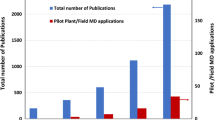Abstract
In this study, five representative, commercially available polymers, Ultem 1000 polyetherimide, Kapton polyimide, phenolic resin, polyacrylonitrile and cellulose acetate, were used to prepare pyrolyzed polymer membranes coated on a porous α-alumina tube via inert pyrolysis for gas separation. Pyrolysis conditions (i.e., final temperature and thermal dwell time) of each polymer were determined using a thermogravimetric method coupled with real-time mass spectroscopy. The surface area and pore size distribution of the pyrolyzed materials derived from the polymers were estimated from the nitrogen adsorption/desorption isotherms. Pyrolyzed membranes from polymer precursors exhibited type I sorption behavior except cellulose acetate (type IV). The gas permeation of the carbon/ a-alumina tubular membranes was characterized using four gases: helium, carbon dioxide, oxygen and nitrogen. The polyetherimide, polyimide, and phenolic resin pyrolyzed polymer membranes showed typical molecular sieving gas permeation behavior, while membranes from polyacrylonitrile and cellulose acetate exhibited intermediate behavior between Knudsen diffusion and molecular sieving. Pyrolyzed membranes with molecular sieving behavior (e.g., polyetherimide, polyimide, and phenolic resin) had a CO2/N2 selectivity of greater than 15; however, the membranes from polyacrylonitrile and cellulose acetate with intermediate gas transport behavior had a selectivity slightly greater than unity due to their large pore size.
Similar content being viewed by others
References
M. Perez-Mendoza,et al., Carbon,44, 638 (2006).
D. Q. Vu, W. J. Koros, and S. J. Miller,J. Membrane Sci.,211, 311 (2003).
H. Suda and K. Haraya,Chem. Commun., 93 (1997).
S. M. Saufi and A. F. Ismail,Carbon,42, 241 (2004).
C. Liang, G. Sha, and S. Guo,Carbon,37, 1391 (1999).
S. H. Park,et al., Macromol. Res.,11, 157 (2003).
H. Suda and K. Haraya,J. Phys. Chem. B,101, 3988 (1997).
A. Singh-Ghosal and W. J. Koros,J. Membrane Sci.,174, 177 (200).
T. A. Centeno and A. B. Fuertes,Sep. Purif. Technol.,25, 379 (2001).
T. A. Centeno, J. L. Vilas, and A. B. Fuertes,J. Membrane Sci.,228, 45 (2004).
A. F. Ismail and L. I. B. David,J. Membrane Sci.,193, 1 (2001).
W. Zhou,et al., J. Membrane Sci.,217, 55 (2003).
Y. K. Kim, H. B. Park, and Y. M. Lee,J. Membrane Sci.,251, 159 (2005).
Y. K. Kim, H. B. Park, and Y. M. Lee,J. Membrane Sci.,226, 145 (2003).
D.o.B.-R.L. Sadtler Research Laboratories The Infrared Spectra Atlas of Monomers and Polymers, 1984.
R. K. Mariwala and H. C. Foley,Ind. Eng. Chem. Res.,33, 607 (1994).
L. I. B. David and A. F. Ismail,J. Membrane Sci.,213, 285 (2003).
H. M. Jeong, M. Y. Choi, and Y. T. Ahn,Macromol. Res.,14, 312 (2006).
B. Grzyb,et al., J. Anal. Appl. Pyrol.,67, 77 (2003).
D. S. Kim,et al., Macromol. Res.,13, 314 (2005).
M. G. Sedigh,et al., Ind. Eng. Chem. Res.,38, 3367 (1999).
X. Zhang,et al., Sep. Purif. Technol.,52, 261 (2006).
D. K. Kim,et al., Macromol. Res.,13, 521 (2005).
E. P. Barrett, L. G. Joyner, and P. P. Halenda,J. Am. Chem. Soc.,73, 373 (1951).
I. Mochida and S. Kawano,Ind. Eng. Chem. Res.,30, 2322 (1991).
Jeffrey C. S. Wu, D. F. Flowers, and P. K. T. Liu,J. Membrane Sci.,77, 85 (1993).
J. Gilron and A. Soffer,J. Membrane Sci.,209, 339 (2002).
J. Hayashi,et al., Ind. Eng. Chem. Res.,34, 4364 (1995).
J. Hayashi,et al., Ind. Eng. Chem. Res.,35, 4176 (1996).
M. Yamaoto,et al., J. Membrane Sci.,133, 195 (1997).
A. Lapkin,Membr. Tech.,116, 5 (1999).
W. Wei,et al., Carbon,40, 465 (2002).
W. Zhou,et al., Ind. Eng. Chem. Res.,40, 4801 (2001).
Author information
Authors and Affiliations
Corresponding author
Rights and permissions
About this article
Cite this article
Jung, C.H., Kim, G.W., Han, S.H. et al. Gas separation of pyrolyzed polymeric membranes: Effect of polymer precursor and pyrolysis conditions. Macromol. Res. 15, 565–574 (2007). https://doi.org/10.1007/BF03218832
Received:
Revised:
Issue Date:
DOI: https://doi.org/10.1007/BF03218832




